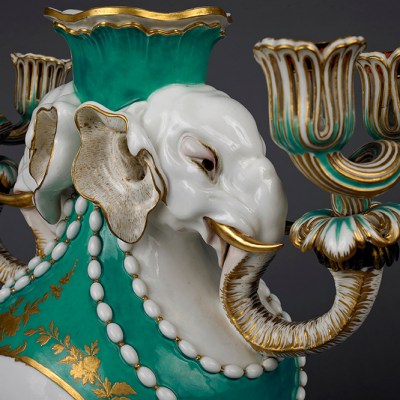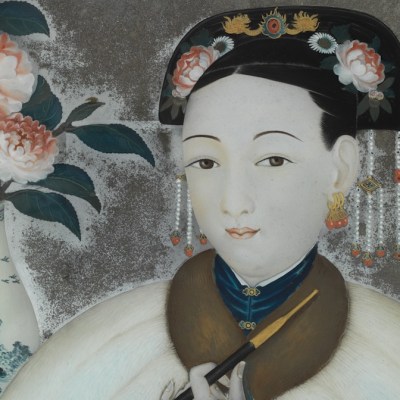Do we know Sèvres? We might know its useful wares of the 18th century: teacups with burnished gold handles, dishes rimmed in celestial blue, vases with pleasant vignettes in central roundels. We might not, however, recognise the Sèvres of the following centuries, when restless tastes shaped ceramics into forms new and strange. Early 19th-century works, bristling with ornament and encrusted with chimeras, fluid nouveau and blocky deco sculpture of the late 19th and early 20th centuries, porcelain modern and postmodern – all are on view at the Bard Graduate Center in ‘Sèvres Extraordinaire’. Most of these objects have never been seen in the United States.

The show defines sculpture in its broadest sense, encompassing figurative work, vases and vessels of all sorts – as well as salt cellars and coffee pots, which we number among those things that might have been used, or may have simply been admired, their putative function a pretext for their often improbable forms. By insisting that we see this porcelain as sculpture, the exhibition’s curators dispute the second-class status often assigned to decorative art. It’s a chance to expand our understanding of what sculpture is, how it’s made (not just by one set of hands, but by many and in multiples), and where it goes.
Does sculpture go on the dining table? When part of the assemblage known as the surtout, yes. From the 18th century onwards, it was the custom for elite tables to be adorned with dozens of small-scale sculptures, which stood amid the dishes and the meal’s other accoutrements. Sèvres produced many of these ensembles, often for royal and imperial clients. Among these is the surtout delivered to Catherine the Great, Empress of Russia, in 1779. Its amazing centrepiece, on view here, was modelled by Louis-Simon Boizot, honouring the ruler as a patron of the arts and sciences. A staggering number of figures – allegorical embodiments of painting, music, architecture, geography and other domains – cluster together with putti around a column topped with a bust of Minerva (originally a portrait of the empress, who disliked her likeness and had it replaced). Although its immaculate whiteness recalls marble, this sculpture was not carved. Rather, each of its elements were painstakingly cast, then assembled. Like most of Sèvres’s 18th-century output, the completed work was left unglazed to permit crisp detail at a vanishingly minute scale.

As works such as the Catherine the Great surtout demonstrate, Sèvres was intimately entangled with state power. The manufactory came under the protection of the crown in 1759 and remains the property of the French state to this day. By producing replicable and relatively affordable sculpture, Sèvres encouraged its consumers to bring that state into their homes. The exhibition includes one of the manufactory’s countless commemorations of Napoleon, a porcelain portrait bust of the general-turned-emperor (its crown of bronze laurels an optional add-on).

The associations with wealth and power are inescapable and this can be alienating, if one casts an even slightly critical eye on pre- and post-Revolutionary French history. Yet I like to think that decorative objects also offer a certain kind of freedom, from lessons, morals and meaning. What can one say, standing before a teacup shaped into the striated bulb of a stalk of fennel? Such an object admits little interpretation but invites much pleasure. This is not to say that research stops at the porcelain object. The 500-page catalogue that accompanies this exhibition, the first comprehensive resource in English on the sculpture of Sèvres, is a tremendous boon for those with an academic or connoisseurial interest in the manufactory. Sometimes, however, it can also be enough to look.
Porcelain, in its glossy impermeability, has something of a not-made-by-human hands quality, which is why the exhibition’s attention to making is so welcome. Many works of art are displayed next to evidence of the processes that produced them. Working backwards from one object – an 18th-century hors d’oeuvres platter scattered with floral sprigs – we see the plaster mould in which it was cast, then its concept drawing in chalk. Another preparatory work by the same maker, Jean-Claude Duplessis, père, reintroduces the artist’s hand. Here, frothing waves, scraped into fragile terracotta, crash into one another and coalesce in the form of a saucière, or sauce dish. Models like these served as the positive for a plaster mould’s negative and were often destroyed in the process, making this a precious survival and a singular sculpture.

Although all porcelain is collaborative, requiring the specialised labour of many hands, the designers take top billing. Names such as Boizot and Alexandre-Évariste Fragonard (the son of the painter) lent the manufactory prestige in the 18th and 19th centuries. Visitors to the exhibition might also note two vases by Auguste Rodin, whose beginnings as a decorative sculptor have been overshadowed by his later career. Despite this long history of artist collaborations, it’s still a pleasant surprise to see the names of modern and contemporary artists – Louise Bourgeois, Yayoi Kusama – attached to Sèvres objects.

(sculptors), Suzanne Estelle Apoil (painter). Manufacture et Musée nationaux, Sèvres. Photo: © RMN-Grand Palais (Sèvres – Manufacture et musée nationaux)/Martine Beck-Coppola
Some collaborations feel more apt than others. Bourgeois’s Nature Study of 1998 is a crouching headless sphinx with three heavy sets of breasts, with an extended phallus between its haunches. It is undeniably imposing, but it’s hard to sense the presence of porcelain within its gilded solidity. Ettore Sottsass’s Vase Diane, a stacked monument of wine-dark purple platters and a fire-engine-red bowl, and his surtout, a abstract multiplicity of cones, spheres, rods and doughnuts, which marry matte white biscuit porcelain with gleaming gilding, show the strengths of contemporary Sèvres. The flat geometry and rich palette of the Memphis style shine in Sottsass’s departure from plastic and foray into porcelain.
At the end of the day, porcelain is clay. On the exhibition’s fourth floor, a short film shows the transformation of powdered kaolin, quartz and feldspar into moist porcelain paste. The paste is pressed into moulds, the casts are pieced together, the sculpture is fired. From the kiln emerges a sculpture. This process, more or less, has been going on without interruption for the past two-and-a-half centuries, but that doesn’t make it any less extraordinary.

‘Sèvres Extraordinaire! Sculpture from 1740 until Today’ is at the Bard Graduate Center, New York, until 16 November.



